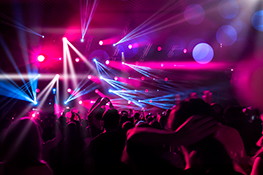The Power of Color Temperature: Optimizing Your Stage Lighting for Different Events
Understanding Color Temperature
Color temperature, measured in Kelvin (K), dictates the warmth or coolness of a light source. Lower Kelvin values (e.g., 2700K) produce warm, yellowish hues reminiscent of incandescent bulbs, while higher values (e.g., 6500K) generate cool, bluish light similar to daylight. Understanding this spectrum is crucial for creating the right atmosphere for any event. This article delves into how to leverage color temperature to enhance the impact of your stage lighting.
Warm Hues for Intimate Gatherings
Creating a Cozy Ambiance
For events like weddings, intimate concerts, or corporate dinners, warmer color temperatures (2700K-3200K) are ideal. These tones foster a feeling of comfort, intimacy, and romance. They create a visually appealing glow on performers and guests, enhancing the overall mood. Consider using amber gels or warmer-toned LED fixtures to achieve the desired effect. The warmth helps to emphasize skin tones naturally, making performers look their best.
Selecting the Right Fixtures
When choosing fixtures for warm lighting, tungsten halogen or LED fixtures with adjustable color temperature are your best bet. Remember to consider the overall size of the venue; a larger venue may require more fixtures to evenly distribute the warm glow.
Cool Hues for High-Energy Performances
Enhancing Dynamism and Focus
In contrast, high-energy events such as rock concerts, theatrical productions, or sporting events benefit from cooler color temperatures (5000K-6500K). These cooler tones create a vibrant, energetic atmosphere and can effectively highlight specific areas on stage. The crisp, clear light improves visibility and detail, enhancing the visual impact of fast-paced performances.
Strategic Placement for Maximum Impact
Strategic placement of cool-toned lights is key here. Focus lights can be used to spotlight individual performers, while wash lights create a dynamic, overall ambiance. The use of contrasting warm and cool light can further enhance the dramatic effect.
Neutral Color Temperatures for Versatile Events
Achieving a Balanced Atmosphere
Neutral color temperatures (around 4000K) provide a balanced, versatile option suitable for various events. This middle ground offers a clean, crisp light without being overly warm or cool, making it perfect for presentations, conferences, or events requiring a more neutral atmosphere. It allows for a more natural representation of colors on stage.
Flexibility and Adaptability
The advantage of using neutral color temperature is the flexibility it offers. It provides a solid foundation that can be easily adjusted with gels or other color-enhancing tools to achieve specific effects as needed throughout the event. This adaptability makes it a popular choice for versatile venues.
Color Temperature and Skin Tones
Optimizing Appearance
It’s crucial to consider how color temperature affects skin tones. Warmer tones generally flatter skin, while cooler tones can sometimes wash out complexions. However, clever use of cool tones can also create a dramatic or stylized effect. Understanding your performers and their needs is vital for selecting the optimal color temperature.
Calibration and Adjustment
Remember that subtle shifts in color temperature can make a significant difference. Calibrating your lighting equipment and having the ability to adjust color temperature during the event offers optimal control and allows for on-the-fly corrections.
Conclusion: Mastering the Art of Color Temperature
Mastering the use of color temperature is a cornerstone of effective stage lighting. By understanding the nuances of different color temperatures and their impact on atmosphere and aesthetics, you can elevate your stage lighting designs to a new level, creating unforgettable experiences for your audiences. Explore the options available at stagelights.in to find the perfect lighting solutions for your next event.


 Auditorium Construction Services
Auditorium Construction Services 